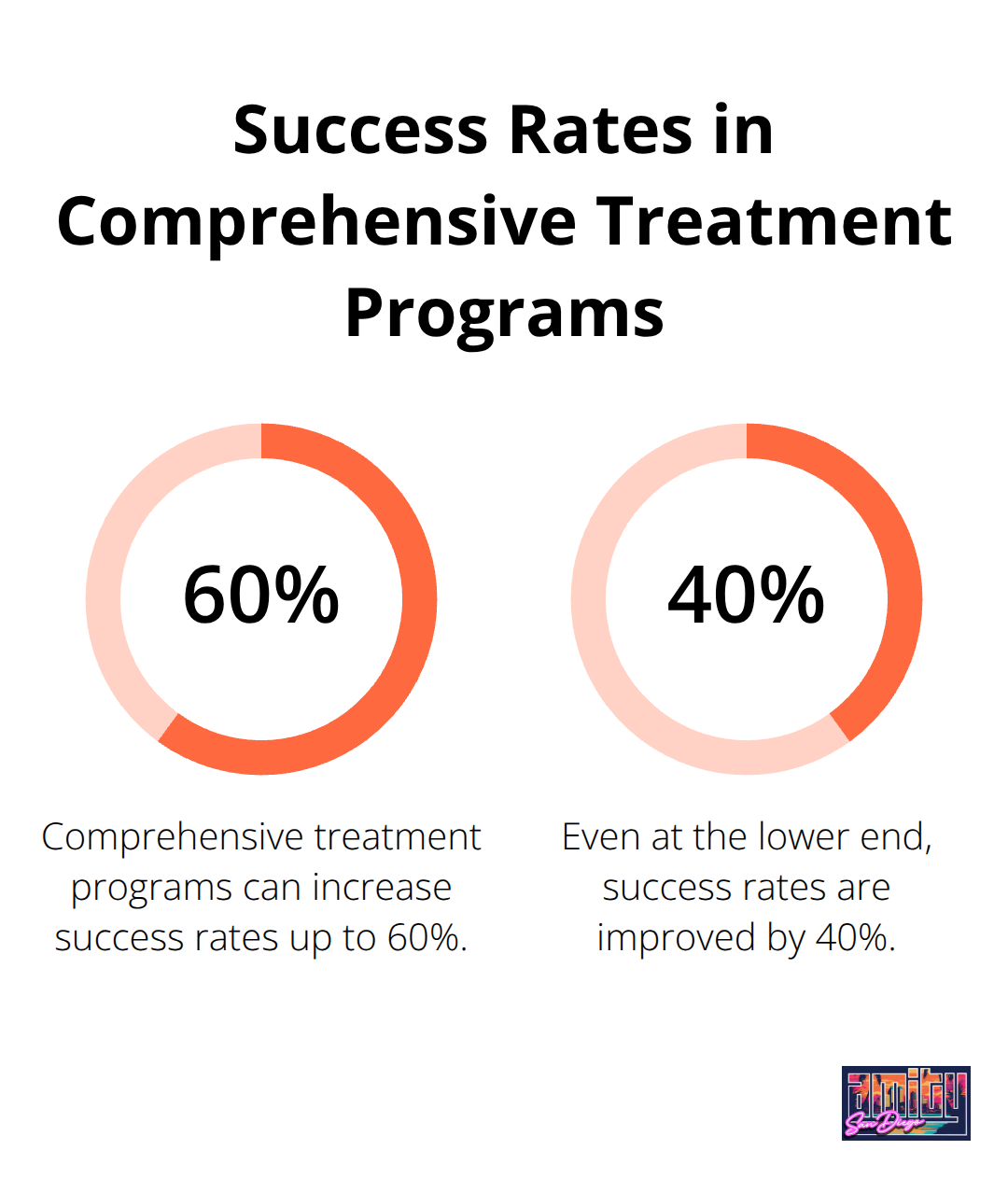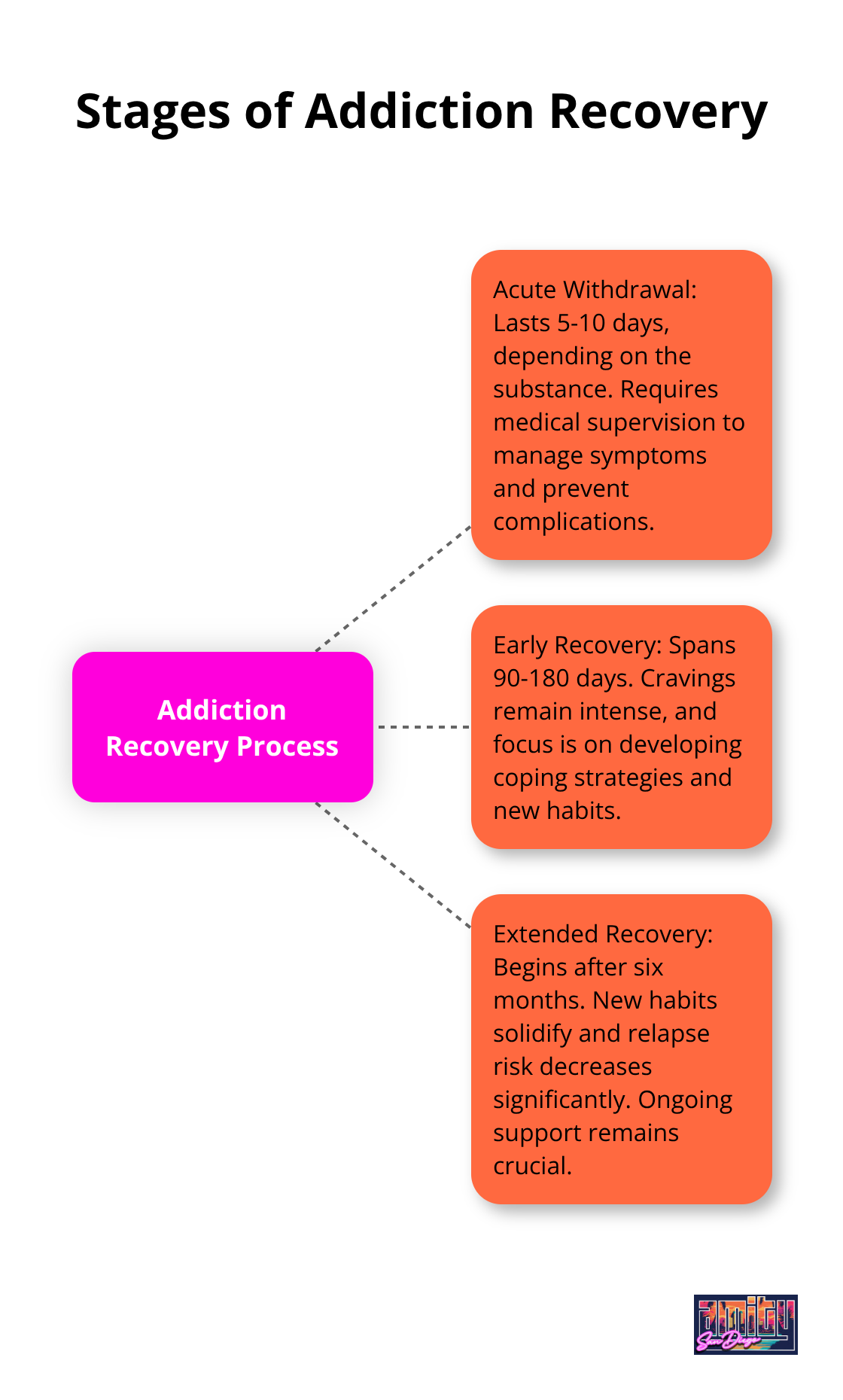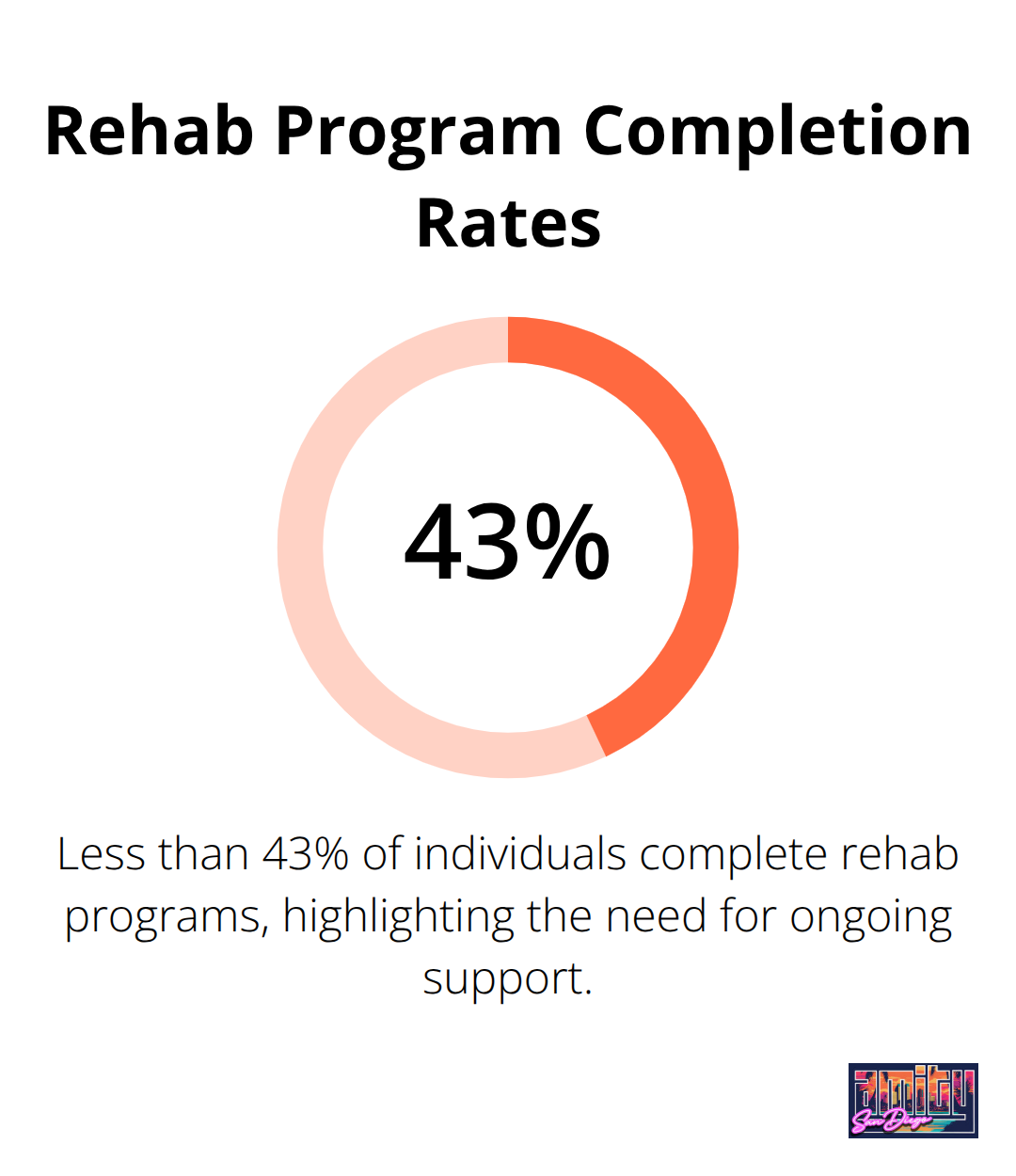Addiction affects millions of Americans, yet only 10% receive the treatment they need according to SAMHSA data. The path to recovery isn’t linear, but research shows that comprehensive treatment programs increase success rates by 40-60%.
At Amity San Diego, we’ve seen firsthand how the right combination of medical care, therapy, and support transforms lives. Successful addiction recovery requires understanding the process and having access to evidence-based treatment options.

What Does the Recovery Process Really Look Like
Addiction operates as a chronic medical condition that affects brain chemistry, behavior patterns, and physical health. The National Institute on Drug Abuse confirms that addiction changes brain structure and function, which makes recovery a medical process rather than a simple matter of willpower. This medical reality means successful recovery requires professional intervention, ongoing management, and evidence-based treatment approaches just like diabetes or heart disease.
Recovery Follows Predictable Stages
Recovery moves through distinct phases that most people experience. The acute withdrawal phase lasts 5-10 days (depending on the substance), followed by early recovery that spans 90-180 days when cravings remain intense. Extended recovery begins after six months when new habits solidify and relapse risk decreases significantly. Professional treatment programs demonstrate significantly higher success rates than self-directed attempts. These timeframes help set realistic expectations and prevent premature treatment exits during challenging periods.

Professional Treatment Creates Success
Professional treatment programs achieve substantially higher success rates than self-directed recovery attempts. Comprehensive treatment programs achieve 40-60% success rates by addressing the medical, psychological, and social aspects simultaneously through medication management, behavioral therapy, and structured support systems. The combination of medical supervision during early recovery and evidence-based therapies like CBT creates the foundation for lasting change. Treatment centers provide 24/7 medical support when needed and connect patients with peer networks that sustain recovery long-term.
Medical Supervision Prevents Dangerous Complications
Withdrawal from certain substances can cause life-threatening complications without proper medical oversight. Alcohol and benzodiazepine withdrawal can trigger seizures, while opioid withdrawal creates severe physical distress that leads many people back to substance use. Medical professionals monitor vital signs, administer medications to reduce symptoms, and intervene when complications arise. This medical foundation allows people to focus on psychological healing rather than physical survival during the most vulnerable recovery phase.
The medical aspects of early recovery set the stage for the therapeutic work that follows, which requires specific evidence-based approaches to address the psychological components of addiction treatment San Diego.
What Treatment Components Actually Work
Medical detox forms the foundation of effective addiction treatment, yet many facilities rush through this phase. Professional detox programs last 5-10 days and require 24/7 medical oversight because withdrawal from alcohol, benzodiazepines, and opioids can trigger seizures, heart complications, and severe dehydration. Research from NIDA supports studies into the health impacts of overdose prevention programs and their community effects.
Medical Stabilization Prevents Life-Threatening Complications
Physicians administer medications like clonidine for opioid withdrawal or benzodiazepines for alcohol withdrawal to prevent dangerous complications during stabilization. This medical foundation prevents the 72% of people who abandon recovery during the acute withdrawal phase. Medical teams monitor vital signs continuously and adjust medications based on individual responses to withdrawal symptoms.
Evidence-Based Therapies Reshape Brain Function
Cognitive Behavioral Therapy and Dialectical Behavior Therapy demonstrate the strongest research outcomes for addiction treatment. CBT helps people identify triggers and develop coping strategies, while DBT teaches emotional regulation skills that prevent impulsive substance use. Research shows CBT demonstrates efficacy as both monotherapy and part of combination treatment strategies.
These therapies require 12-16 weeks of consistent sessions to reshape thought patterns and behavioral responses. Group therapy sessions provide peer accountability and cost 40% less than individual sessions while maintaining effectiveness (without compromising outcomes). The combination of individual and group therapy creates multiple touchpoints for support during vulnerable periods.
Medication-Assisted Treatment Blocks Cravings
FDA-approved medications like buprenorphine, methadone, and naltrexone significantly improve recovery outcomes for opioid and alcohol addiction. Studies show buprenorphine versus injection naltrexone had relapse rates of 57% versus 65% by 24 weeks. Naltrexone prevents alcohol from producing pleasurable effects and reduces consumption by 50% according to clinical trials.
These medications work best when combined with counseling and behavioral therapies rather than as standalone treatments. Treatment centers that integrate medication-assisted treatment with therapy achieve 65% higher retention rates than programs without medication options.
The medical and therapeutic components create the clinical foundation, but lasting recovery depends equally on the human connections and support networks that sustain motivation through challenging periods. For comprehensive addiction treatment San Diego residents can access evidence-based programs that combine these essential components.
Who Should Be Part of Your Recovery Team
Recovery success depends heavily on the people around you, yet many individuals attempt recovery without adequate support systems according to SAMHSA data. Family members who understand addiction as a medical condition rather than a moral failing provide the strongest foundation for long-term success. However, family involvement requires education about addiction science and boundary establishment to avoid behaviors that inadvertently support substance use.
Professional Treatment Teams Make the Difference
The right treatment facility employs board-certified addiction physicians, licensed clinical social workers, and certified addiction counselors who work as an integrated team. Look for facilities accredited by the Commission on Accreditation of Rehabilitation Facilities, which maintains strict standards for staff qualifications and treatment protocols. Treatment centers with lower staff-to-client ratios provide more individualized attention and achieve better outcomes than larger programs. Ask potential facilities about their medical director’s credentials, therapy modalities offered, and average length of stay.
Alumni Networks Provide Accountability
Treatment centers with active alumni programs report lower relapse rates among graduates who participate in community events and peer mentorship. Research shows that less than 43% complete rehab programs, making ongoing support crucial for sustained recovery. Peer support groups like SMART Recovery and Alcoholics Anonymous provide structured frameworks for accountability, though maintaining engagement requires additional support systems.

Family Education Prevents Common Mistakes
Family members often unknowingly enable substance use through well-intentioned actions like providing money, making excuses, or avoiding difficult conversations. Educational programs teach families how to set healthy boundaries while maintaining emotional support. These programs also address the trauma and stress that family members experience, which affects their ability to provide effective support. For comprehensive addiction treatment San Diego resources, families can find specialized programs designed to support both patients and their loved ones.
Final Thoughts
Successful addiction recovery requires three fundamental elements: comprehensive medical care, evidence-based therapy, and strong support networks. Statistics show that people who complete structured treatment programs achieve 40-60% success rates compared to single-digit success rates for self-directed attempts. Professional assessment and medical supervision during withdrawal create the foundation that prevents dangerous complications.
Evidence-based therapies like CBT and DBT reshape thought patterns and behavioral responses over 12-16 weeks of consistent sessions. Treatment teams, family members, and peer networks provide the ongoing support that makes recovery sustainable. Alumni programs and community connections offer accountability during vulnerable periods when relapse risk remains high (particularly in the first six months).
We at Amity San Diego combine medical expertise with personalized care to address both addiction and co-occurring mental health conditions. Our treatment approach integrates the comprehensive elements that research shows lead to lasting recovery success. Contact Amity San Diego to learn how our programs can support your path to recovery.

